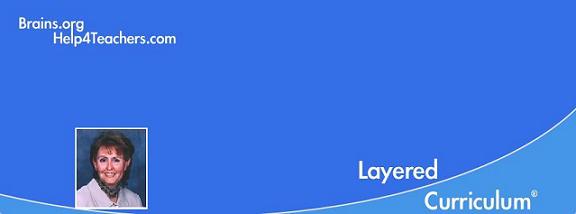__________Layered Curriculum®. . . because every child deserves a special education™_
 |
|
![]() _
_ ![]()
Layered
Curriculum TEXT & WORKBOOK
Set
for only
$43.95
(free shipping in
US)
Tweet
Create Goal-Focused Positive Classrooms
© Dr Kathie F Nunley, 2016A new school year - new ideas, new goals, renewed optimism. Help maintain this positive energy by setting in place an environment that nurtures student self-efficacy, which in turn leads to success and happiness.
Self-efficacy refers to your own personal sense of control over your world. Are you really captain of your own ship, rather than simply a passenger carried along by the winds that blow? Increased self-efficacy creates a sense of well-being and confidence in one's own personal resources. Self-efficacy is a wonderful asset in life, especially helpful in times when problems seem huge and personal resources seem small. Teachers can promote an increase in student self-efficacy through classroom structure, by promoting four core components.
First, promote positive emotions. Broaden and build positive emotions in the classroom. Encourage demonstrate and vocalize curiosity, joy, gratitude, optimism, affection, pride and love. These emotions broaden us to be more open to learning and problem solving.
Second, help students identify personal strengths. Continually remind students of their individual strengths and encourage them to build on them. Offer assignments and projects which take advantage of a wide variety of individual strengths.
Third, help students establish "approach" goals rather than "avoidance" goals. Classroom rules, procedures, self-reflection should all focus on what students need to do to be successful rather than what they should not be doing. Teacher assessment should focus on suggestions for improvement.
Fourth, instill hope. Encourage, push, never give up. Success rarely occurs without failure first.
About the Author:
Dr Kathie Nunley is an educational psychologist, researcher and author of several books on parenting and teaching, including A Student's Brain (Brains.org) and the best selling, "Differentiating the High School Classroom" (Corwin Press). She is the developer of the Layered Curriculum® method of instruction and has worked with parents and educators around the world to better structure schools to make brain-friendly environments. In addition, her work has been used by the Boeing Corporation, Family Circle Magazine, the Washington Post, and ABC television.
Email her: Kathie (at) brains.orgCopyright © 1998 - current year by Kathie F. Nunley.
All Rights Reserved.
Layered
Curriculum is a registered trademark developed by
Dr. Kathie F. Nunley.